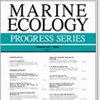Juvenile hawksbill turtle Eretmochelys imbricata movement patterns in Sechura Bay, Peru, assessed with satellite tracking
IF 2.2
3区 环境科学与生态学
Q2 ECOLOGY
引用次数: 0
Abstract
ABSTRACT: The post-capture movements made by hawksbill sea turtles Eretmochelys imbricata in the southeast Pacific Ocean were monitored between 2014 and 2017. A total of 8 hawksbill turtles were fitted with satellite transmitters and released in Sechura Bay, northern Peru. All turtles were classified as juveniles (curved carapace length range: 34.7-47.5 cm) and were captured in a small-scale demersal set net fishery in Sechura Bay. Track durations ranged from 9 to 489 d. Six of the 8 turtles remained within the bay for the duration of their tracking, suggesting its importance as a long-term juvenile foraging site. Two turtles departed the bay and travelled over 1000 km, passing the Galapagos Islands, Ecuador. The satellite tracks of those turtles that remained within the bay showed a significant overlap with areas used by the demersal set net fishery operating there (mean overlap: 33%). The long residence times and high affinity for coastal areas observed in these tagged individuals make the turtles susceptible to multiple threats within the bay, including interactions with intensive small-scale fishing from the ports of Parachique, Puerto Rico, and Bayovar, as well as pollution and contamination from the communities that encompass the bay. More comprehensive measures are needed to quantify and characterize the threats faced by this endangered species in this unique habitat and to recommend practical conservation actions.通过卫星跟踪评估秘鲁塞丘拉湾玳瑁幼龟的活动模式
摘要:2014 年至 2017 年期间,对东南太平洋的玳瑁海龟(Eretmochelys imbricata)捕获后的活动进行了监测。共为 8 只玳瑁海龟安装了卫星发射器,并在秘鲁北部的塞丘拉湾进行了释放。所有海龟均被归类为幼龟(弯曲的胴体长度范围:34.7-47.5 厘米),是在塞丘拉湾的小型底层定置网渔业中捕获的。8 只海龟中有 6 只在跟踪期间一直留在海湾内,这表明海湾是幼龟长期觅食的重要地点。两只海龟离开海湾,经过厄瓜多尔的加拉帕戈斯群岛,行程超过1000公里。留在海湾内的海龟的卫星轨迹显示,它们的活动区域与底栖定置网捕鱼的区域有明显重叠(平均重叠率:33%)。从这些被标记的个体身上观察到的长时间停留和对沿海地区的高度亲近使海龟在海湾内容易受到多种威胁,包括与来自波多黎各帕拉奇克港和巴约瓦尔港的密集型小型捕鱼活动的相互作用,以及来自海湾周围社区的污染。需要采取更全面的措施来量化和描述这一濒危物种在这一独特栖息地所面临的威胁,并提出切实可行的保护行动建议。
本文章由计算机程序翻译,如有差异,请以英文原文为准。
求助全文
约1分钟内获得全文
求助全文
来源期刊

Marine Ecology Progress Series
环境科学-海洋学
CiteScore
5.30
自引率
8.00%
发文量
238
审稿时长
3 months
期刊介绍:
The leading journal in its field, MEPS covers all aspects of marine ecology, fundamental and applied. Topics covered include microbiology, botany, zoology, ecosystem research, biological oceanography, ecological aspects of fisheries and aquaculture, pollution, environmental protection, conservation, and resource management.
 求助内容:
求助内容: 应助结果提醒方式:
应助结果提醒方式:


